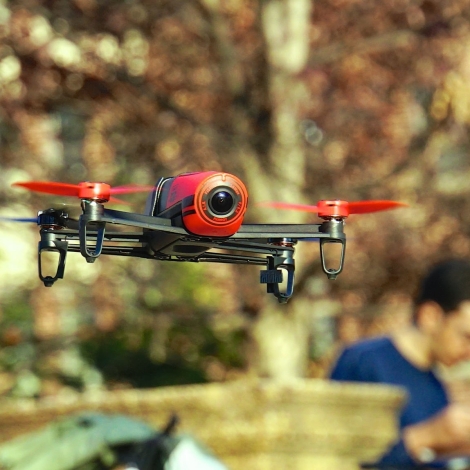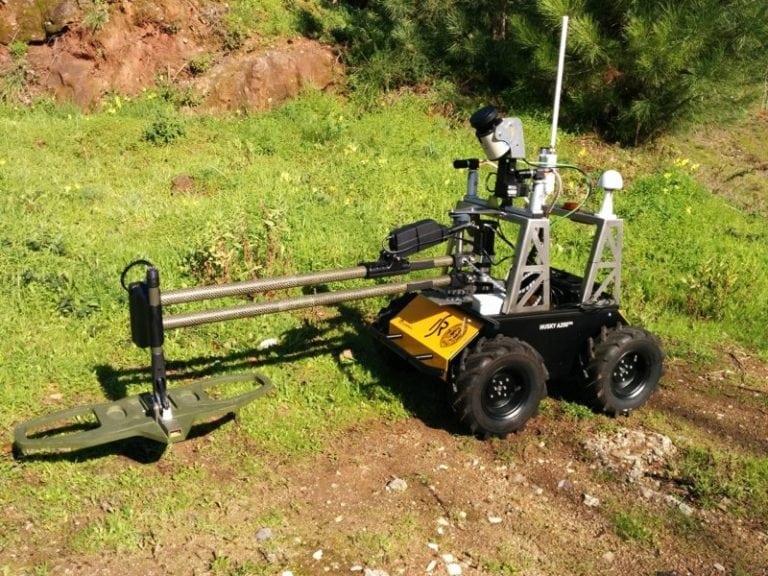 Three robotics labs in Tanzania, Nepal and Peru put aerial drones into the hands of citizens to augment humanitarian work and foment small business. These drones and other robotics are helping to map land, assist in searches and rescues and perform other humanitarian work with guidance by a non-profit called WeRobotics. WeRobotics has established the labs and is sighting more than a dozen future locations worldwide. They aim to train people in the use of robotics as a humanitarian and appropriate technology for global development. We spoke with WeRobotics Co-Founder and Director of Research and Analysis at Direct Relief Andrew Schroeder. Mr. Schroeder also founded the Nethope.org UAV working group and co-directs the UAViators Humanitarian UAV Network. We asked him five questions.
Three robotics labs in Tanzania, Nepal and Peru put aerial drones into the hands of citizens to augment humanitarian work and foment small business. These drones and other robotics are helping to map land, assist in searches and rescues and perform other humanitarian work with guidance by a non-profit called WeRobotics. WeRobotics has established the labs and is sighting more than a dozen future locations worldwide. They aim to train people in the use of robotics as a humanitarian and appropriate technology for global development. We spoke with WeRobotics Co-Founder and Director of Research and Analysis at Direct Relief Andrew Schroeder. Mr. Schroeder also founded the Nethope.org UAV working group and co-directs the UAViators Humanitarian UAV Network. We asked him five questions.
E4C: What are some of the noteworthy ways people are using drones and other robotics?
AS: The key use cases that have emerged recently for drones in particular revolve around mapping or other image-based data collection on the one hand and payload delivery on the other. Mapping applications for social good have been influential in disaster relief around damage assessment, especially using oblique imagery to understand structural damage. Agricultural applications using multispectral imagery to assess crop health, plus basic elevation modeling to understand water flow are at the beginning stages of influence now. Conservation applications using drones to monitor wildlife areas where poaching risks are high, or mapping of wildlife habitats to understand risk dynamics for animal populations are becoming increasingly common. Likewise, studies on areas at risk for climate change including coastal erosion and water levels are becoming more frequent ways to assess baseline ecosystem health, in part to help guide resource allocation for disaster prevention and risk mitigation. Along the same lines, urban baseline mapping, either for understanding risk dynamics like flooding potential, or the evolution of land use is among the most interesting drone applications.
Aerial drones in emerging economies are used to assess soils and vegetation health for farming, mapping, wildlife conservation, medical deliveries and more.
For instance, there is significant work ongoing in Dar es Salaam, Tanzania, to map the areas of informal settlement which make up large chunks of the total urban area, in large part because these areas change so frequently at such granular resolution. In the health sector the far more influential use cases turn on delivery of goods, particularly essential medicines and diagnostic samples. Recently WeRobotics completed an exciting delivery project in the Peruvian Amazon rain forest to deliver snakebite anti-venom to remote clinics. Other really noteworthy cases in that vein include Zipline’s work in Rwanda to establish broad networks for delivery of whole blood and blood samples, and Matternet’s collaboration with UNICEF in Malawi to transport dried blood samples as part of the diagnostic network for pediatric HIV. Doctors Without Borders is also doing interesting work in this field out in Papua New Guinea to support tuberculosis diagnostics.
Apart from drones, the leading areas of work in marine robotics are probably in water quality sensing and underwater inspection. WeRobotics has been involved, for instance, in work in Nepal using OpenROV’s vehicles for underwater exploration of glacial lakes which pose a risk of destabilizing and causing what are called “mountain tsunamis” in areas of the Himalayas. Early experiments are underway likewise in post-flood water monitoring for urban areas and fisheries monitoring for improved aquaculture.
WeRobotics has been involved in Nepal using OpenROV’s vehicles for underwater exploration of glacial lakes, which pose a risk of destabilizing and causing what are called “mountain tsunamis” in areas of the Himalayas.
On the ground-robotics side, the main use case has been in the field of de-mining where groups like Digger, a Swiss-based robotics group, are using small ground robots to improve the efficiency and safety of landmine removal. Likewise, ground robots now often play a role in post-disaster urban search-and-rescue operations. In both the marine and ground cases though, these uses are far more early stage and technically specialized than the use of drones, simply because the commercial robotics market in the aerial space is so much more mature. That means prices tend to be much lower. We have yet to see the DJI [the drone manufacturer] either of the water or the earth, for instance, but we’re already seeing the massive influence of a company like DJI in the air.
E4C: How have technology advances made robotics feasible as a humanitarian technology?
AS: The critical change that happened to aerial robotics which made it feasible for non-specialists in the humanitarian field to deploy was the improvement of sensors and control systems which finally made the technology safe and easy to use. The threshold point was probably the introduction of the Phantom 3 by DJI, which was really the first commercial drone that I would consider more-or-less safe for ordinary users. The ability to access both the GPS and Glonass satellite networks made an enormous difference under the hood in terms of positional accuracy. We now take that basically for granted in new models, but it’s only been around commercially for a couple of years. The Phantom 4 and after built in object-avoidance technology, which is becoming increasingly standard and goes a long way towards using the power of sensors and software to enable all types of users to make safe decisions in flight.
The critical change that happened to aerial robotics which made it feasible for non-specialists in the humanitarian field to deploy was the improvement of sensors and control systems which finally made the technology safe and easy to use.
Honestly, I would also include here the emergence of software applications like Pix4D’s Capture app and DroneDeploy, both of which make it very easy for relatively novice users to program their vehicles on smartphones, for both 2D and 3D photogrammetry. Prices for that kind of technology are still pretty high, but they’re coming down fast as the demand for drone mapping increases. Esri, Pix4D and DroneDeploy now make it pretty standard to utilize multispectral data, which is going to open up much of the space around drones for agricultural productivity. Given how many people worldwide depend upon agriculture for their primary livelihood that can have really significant impact. A lot of this work was presaged by the creation of the open source Mission Planner application on the flight control side, which continues to be pretty influential especially for the piloting of fixed-wing drones. Open source photogrammetry is still at very early stages but there’s been a lot of interesting forward movement on the Open Drone Map photogrammetry project recently. In a related sense, the creation of Open Aerial Map has moved the entire community towards much easier and more flexible ways to share aerial imagery publicly, which in turn is having significant impact on the broader humanitarian issue areas of data collaboration and sharing.
E4C: In what ways do you see the field evolving in the next five or 10 years?
AS: That’s a big question, but here’s a general sense of things from my point of view. First, I think you’re going to see the drone market become commoditized pretty rapidly. Hardware has already become a very hard market for anyone outside DJI to compete effectively in. That trend is only going to accelerate as drone hardware just continues to get better, safer, and more accurate at the same time that it gets much, much cheaper across the board. You’re probably in the not-too-distant future going to see the pricing changes which have affected the multicopter market so extensively begin to influence the fixed-wing market.
As prices fall, sensors and processing improve, and interface design reduces barriers to non-specialists, you’re going to see this work just absolutely explode in popularity throughout the world.
You’re going to see a narrowing gap between professional and consumer drone products, such that five years from now, the “prosumer” mid-level products are going to seem dramatically more powerful than the types of technology being used for exclusively professional uses now. You’re also going to see drones start to be equipped with networking capabilities and dramatically enhanced on-board processing capabilities so that much of the work we’re now spending a lot of time on post-mission, making maps and other data products for instance, will be done in near-real-time either in the cloud or on the device itself. You’re going to see the carrying capacity and distance capabilities of payload drones expand just as the prices come down there as well, making it increasingly feasible to use robotics technologies to offload a portion of critical supply chains, especially in remote areas. And you’re probably going to see many of these same gains extended out to the marine and ground robotics space as well, so that the use cases for integrated, multi-landscape robotics becomes much more prevalent.
You’re going to see the carrying capacity and distance of payload drones increase just as the prices come down, making it increasingly feasible to use robotics technologies in critical supply chains, especially in remote areas.
The key issue throughout, though, becomes the intersection of price, safety and ease of use. As prices fall, sensors improve, processing allows for more on-board intelligence and interface design reduces barriers to non-specialists you’re going to see this work just absolutely explode in popularity throughout the world.
E4C: What advances would you like to see in the technology that you work with? What do you think people should focus on to advance the field?
AS: Well, I think a lot of that is what I just described in terms of on-board and cloud-based intelligence. The principle I’d really like folks to think through is how we can get the robotics out of the way of the use cases. The more we can make automated systems cheap, safe and easy to use, the more we can treat them simply as another tool among others, and focus ourselves less on the tech and more on the social impact side of things. This is really important from a user-centered design point of view.
The more we can make automated systems cheap, safe and easy to use, the more we can treat them just as another tool among others. Then we can focus ourselves less on the tech and more on the social impact.
I mean, producing sustainable social impact is really hard work. It gets harder if you also have technology acting in obtrusive ways which calls more attention to itself than to the true goals, which are things like improving livelihoods for the poor, making sure more people survive disasters, helping communities adapt to climate change, strengthening health care logistics, etc.
We need to have engineers and students working closely with us to understand how this stuff performs in the field and how it can make itself as unobtrusive as possible.
So, we need to have engineers and students working closely with us to understand how this stuff performs in the field, how it can make itself as unobtrusive as possible, so that we use it to get better and better over time at the hard work of sustainable social impact. We’d love to work with your readership on that set of problems.
E4C: Story time: Would you describe a moment when you realized that you’re in the right line of work?
AS: I don’t know if there was one single moment honestly, but I’ll give you a great moment which I just experienced.
A couple of weeks ago I was out in Liberia on a project to support the expansion of community health worker operations in very remote areas of the country that were hit hard by the Ebola epidemic not too long ago. I made some maps to help them think about how we can produce more accurate ways to guide community health workers in their outreach efforts.
At one particular clinic, I was just mobbed while I was flying by people of all ages: parents, grandparents, young kids, clinical staff, community health workers, all of whom were just beyond enthusiastic about what I was doing and how it was going to help them. We sat down and had some great discussions about what kinds of images the drone was producing, how they related to the community maps they already have, and what it would take to continue doing more of this work. The spirit of hope and enthusiasm and engagement was just infectious, a real antidote to so much of the pessimism you hear around the world these days.
I thought, ‘this is it. This is what I’m really here for – not to use technology, but to make sure that technology is used in a way that binds us closer together as people.’
And I thought, ‘this is it. ‘This is what I’m really here for – not to use technology, but to make sure that technology is used in a way that binds us closer together as people, solves real problems that local communities need to have solved, and which promises to lead at least incrementally towards a better world for the most vulnerable among us.’ That, to me, is the core vision of WeRobotics. It’s what gets me up in the morning and keeps me going late at night, often for many days at a time without a break. It’s what I think of as a kind of practical utopianism, progressively inspired but tempered by social humility, which the world needs a lot more of right now.


Really it is useful article. I like it thanks for your efforts.